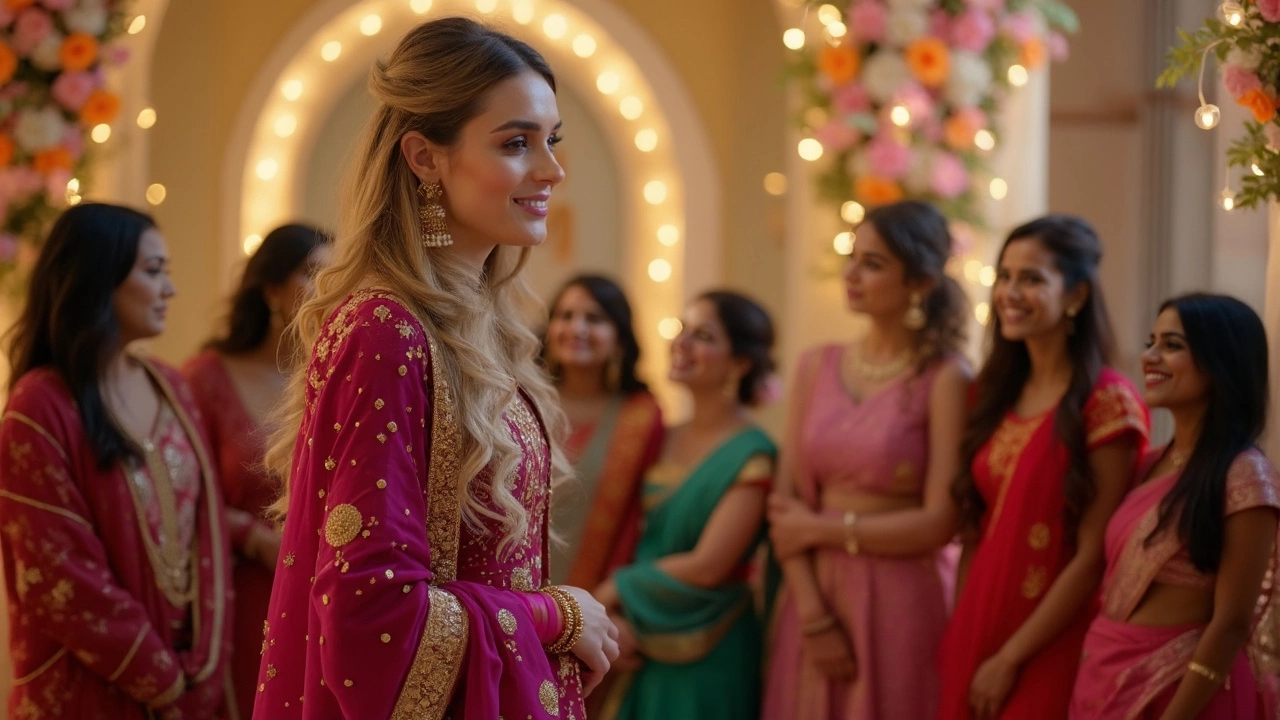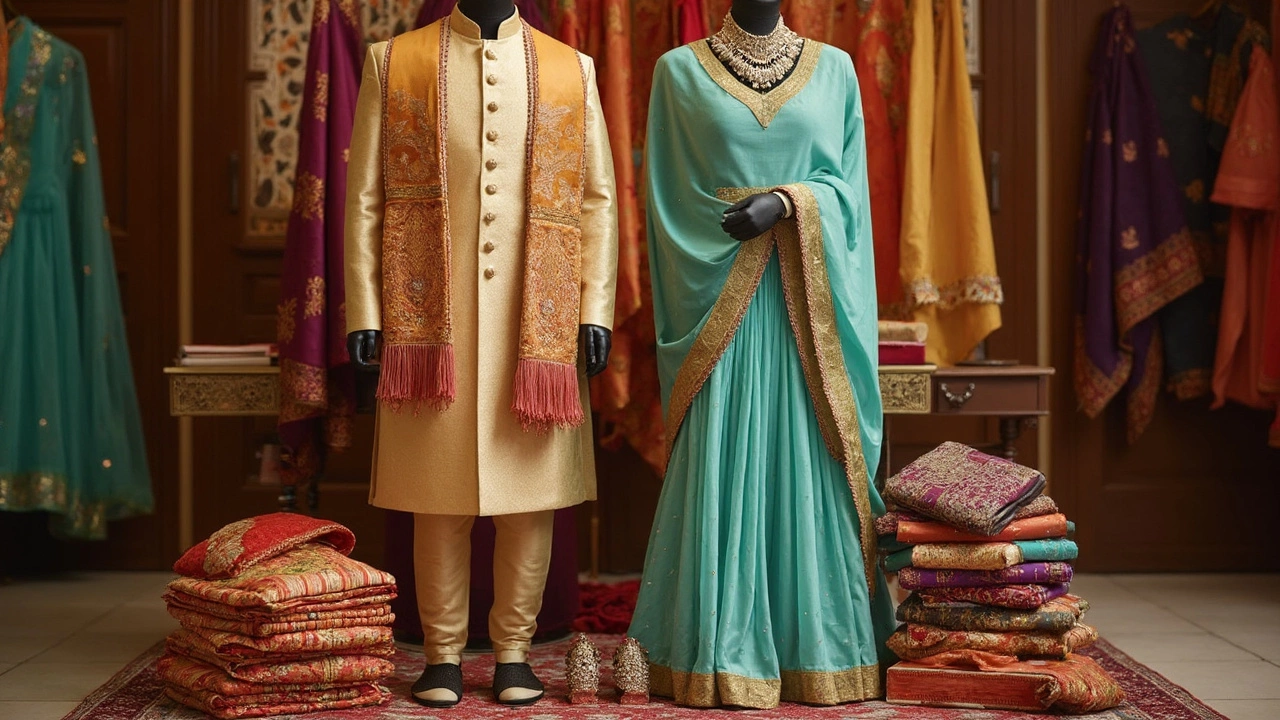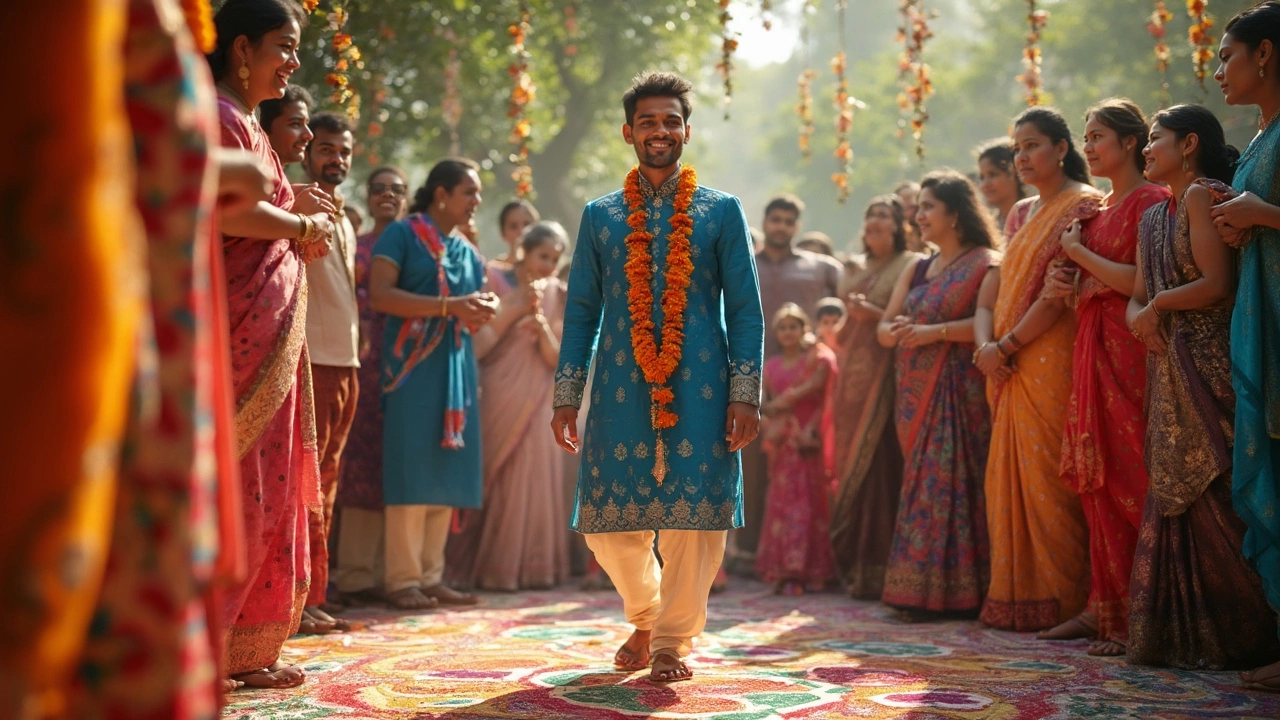Staring at your closet and not seeing a single sherwani or sari? You’re not alone. Showing up at an Indian wedding as a white guest can feel like navigating a dress code from another planet. But here’s the good news: it’s not about perfection—it’s about showing respect and joining in the fun.
Most Indian weddings are all about color, sparkle, and celebration. This isn’t the place for little black dresses or stiff tuxedos. Instead, think about blending in with the vibe: bright colors, elegant fabrics, and a bit of bling (don’t worry, you don’t have to go wild if you’re not into it). Guys often wear long tunics called kurtas, maybe a Nehru jacket, with loose pants or even tailored jeans for a modern twist. Women might pick a lehenga skirt, a flowy gown, or a saree (yes, you can totally wear one even if you’re not Indian—people love it when you make the effort).
Don’t sweat getting the details perfect. The main thing? Avoid head-to-toe white or black, since those colors have specific meanings (white for mourning in many traditions, black can be seen as bad luck). If you’re stuck, jewel tones like royal blue, maroon, or green always hit the mark. And if shopping for something totally new feels overwhelming, there are plenty of rental options both online and in bigger cities—yep, you can rent a full wedding look and return it after.
- Decoding the Dress Code: What’s Expected?
- Best Colors and Fabrics: Stand Out Without Going Overboard
- What NOT to Wear (and Why It Matters)
- Where to Shop and How to Get the Right Fit
- Pro Tips for Comfort and Confidence
Decoding the Dress Code: What’s Expected?
First thing to remember: there isn’t one universal rule for every indian wedding. Dress code can change depending on the family, religion, or the specific event within the wedding (there are often several!). But most invites or the couple’s website will give you clues. Common dress codes include traditional Indian attire (like sarees and kurtas), Western formal, or "Indian formal" which is just a nice way of saying, “Come looking sharp, but join the Indian vibe.”
Here’s what each guideline usually means:
- Traditional Indian: Go for Indian clothes—lehenga, saree, or salwar kameez for women; kurta-pajama or sherwani for men.
- Indian formal: If you don’t have traditional clothes, wear Western formal with bright colors. Suits and ties for men (skip the all-black), colorful dresses (not white) for women.
- Western formal: Same as you’d wear at a Western wedding, but throw in some color and maybe festive jewelry.
Most invited non-Indian guests choose a kurta (long tunic) with dress pants or a lehenga or flowy skirt with a nice top. You don’t have to nail it perfectly; making an effort with those classic wedding outfit pieces is enough, and usually appreciated.
Don’t be shy about asking the couple or bridal party for advice — they’ve had tons of guests with the same questions. Some families even organize group shopping trips or lend outfits, so don’t be surprised if you’re offered something to borrow.
Events to expect include:
- Mehendi or Haldi: Slightly more casual, but still festive. Semi-formal, colorful outfits or lighter Indian wear is great.
- Wedding Ceremony: More formal. This is where you go bigger with color and style – team up with fellow guests if you want to rent Indian clothes or buy accessories together.
- Reception: Glitzy, party vibe. Gowns, fancy sarees, or flashy kurtas work well.
Fun fact: A survey by WeddingWire in 2023 showed 68% of guests at multicultural weddings chose to try traditional outfits. Turns out, blending in is a lot more fun than standing out.
Takeaway? Check with the couple, read the invitation carefully, and opt for colorful, respectful styles. The effort matters way more than being 100% on trend with Indian fashion.
Best Colors and Fabrics: Stand Out Without Going Overboard
If you're going to an Indian wedding, forget everything you know about blending in. Here, bold is normal and bright colors are basically required. But you don't want to go overboard or accidentally pick a color that screams 'wrong choice,' right?
Let’s talk colors first. Deep reds, royal blues, emerald greens—these always work. Gold and silver are also crowd-pleasers for both men and women, and they show up a lot in Indian outfits. Soft pinks, purples, and yellows are good too, especially for daytime events. Just remember, avoid pure white and black. In most Indian cultures, white is for funerals and black is considered unlucky for celebrations. If you’re worried, ask your host for a heads-up on the preferred color vibe for each event.
Here's a quick guide to the go-to colors and what they're usually linked to:
| Color | Why It’s Great | When to Wear |
|---|---|---|
| Red/Maroon | Traditional, festive, said to bring good luck | Weddings, main events |
| Royal Blue | Lively, elegant, always safe | All functions, works for everyone |
| Gold/Silver | Shiny, party feel | Receptions, evening events |
| Green | Symbolizes happiness and harmony | Mehndi, sangeet, smaller events |
| Pastels | Light-hearted vibe, trendy | Daytime or summer celebrations |
Moving on to fabrics, here’s where comfort and style team up. Go for things like silk, chiffon, georgette, or cotton blends—they drape well and keep you cool during those marathon ceremonies. Velvet or brocade feel fancy for winter weddings, but they get hot fast if you’re outside in summer. Men in a kurta will find silk or cotton work, while women in a lehenga or sari look great in anything with a little shine or embroidery—but not so much you feel like a disco ball.
- Pro tip: Outfits with some embroidery, sequins, or beadwork fit right in. If you’re nervous about too much flash, just keep accessories simple.
- Big patterns or prints are normal—think flowers, paisleys, or geometric shapes.
- If you're wearing a scarf or dupatta, lightweight fabrics won’t drive you nuts as things heat up on the dance floor.
Skip anything itchy or tight—remember, you’ll be moving, eating, and (probably) dancing like never before. That’s the real secret to pulling off the wedding outfit at an Indian celebration: have fun with color, but be comfy enough to enjoy it.

What NOT to Wear (and Why It Matters)
If you want to avoid a cringe moment at an Indian wedding, be careful about what you pull out of your closet. Not everything that's cool at a Western wedding flies here. And honestly, the list of "don'ts" is way more important than you might think.
- No all-white outfits: In many Indian cultures, white is the color of mourning. Rolling up in a head-to-toe white look can send a message of sadness instead of celebration. A little white mixed with color is fine, but leave that crisp white shirt or dress at home.
- No all-black looks: This color is usually linked to bad luck or somber occasions in India. Wearing all-black—suit or dress—just doesn't fit the vibe. Save it for another event where it's a safer bet.
- Steer clear of revealing or super casual clothes: Think twice before wearing a super short dress, plunging neckline, spaghetti straps, or shorts. Indian weddings usually lean traditional, and covering shoulders, cleavage, and knees is a smart move, for both men and women. Denim jeans with holes or a t-shirt just look out of place.
- Avoid shoes that are hard to remove: Many Indian ceremonies mean taking off your shoes, especially inside temples or even some homes. Complicated boots or strappy heels? Skip those unless you want to struggle in front of a crowd.
- Don’t copy religious attire: Some clothes have special meaning, like the groom’s turban or the bride’s heavy jewelry set. Avoid anything that can be mistaken for a bridal or priest's role. If you aren’t sure—ask.
If you’re wondering why it matters, it all comes down to respect. Indian wedding traditions hold a ton of meaning for the couple and their families. Rocking up in something seen as disrespectful can stick out in a bad way, but blending in—even if it’s with rented or borrowed gear—gets you a ton of points.
Here’s a quick look at the top clothing mishaps people make:
| Outfit Mistake | Why It’s an Issue |
|---|---|
| All-white dress/suit | Symbol of mourning, not celebration |
| All-black attire | Traditionally bad luck, seen as inauspicious |
| Shorts, tank tops, ripped jeans | Too casual/disrespectful for the occasion |
| Bridal-looking lehenga/sari | May outshine the bride or send the wrong message |
| Shoes with lots of buckles/laces | Awkward during shoe-removal rituals |
Where to Shop and How to Get the Right Fit
Let’s be real: you’re not about to find a legit indian wedding outfit at your local shopping mall. The good news? Shopping for Indian outfits is way easier than it used to be, especially if you know where to look. Tons of online stores ship worldwide, and some even let you rent an outfit—handy if this is a one-time thing.
Popular online sites for Indian wedding guest outfits include:
- Utsav Fashion – Reliable for men’s kurtas, sherwanis, and women’s lehengas and sarees. Sizing is generous, but always check the size chart.
- CBazaar – Huge range, from basic to super fancy. Good mix of traditional and modern looks.
- India Emporium – Great if you want custom tailoring. Upload your measurements for a nearly perfect fit.
- Flyrobe – For rentals in bigger US and Indian cities. You choose the look, they handle dry cleaning and shipping.
If you’re lucky and live close to a big city, swing by the Indian neighborhood or “Little India”—places like Edison, NJ, or Artesia, CA. You get to try things on, and the shop owners usually know just what works for a non-indian guest at a wedding.
Here’s how to make sure that new lehenga or kurta actually fits:
- Always check the measurement guides on the site—Indian sizing is usually smaller than typical US or European sizes.
- If possible, give your exact measurements (shoulders, chest, waist, hips, and height) when ordering online. Most stores do custom tailoring for little or no extra cost.
- For women’s sarees, you’ll need a blouse and petticoat. Some places let you customize the blouse style and fit.
- If something arrives and it’s a bit loose, take it to a local tailor—hemming a lehenga or adjusting a kurta is usually simple and cheap.
Fun fact: Renting an outfit isn’t just thrifty, it’s normal—even in India. This is especially handy for high-end sherwanis and lehengas, which can easily cost $200-$600 if you buy new.
| Buying Option | Approximate Price Range | Best For |
|---|---|---|
| Online (Buy) | $60-$300 | Wider selection, made-to-order |
| Online (Rent) | $40-$120 | One-time wear, latest trends |
| In-Store | $80-$350 | Try before you buy, instant fit checks |
You don’t need to shell out a fortune, but it’s worth putting a little thought into your wedding outfit—photos last forever. Choose comfort first: if something’s itchy or awkward now, it’ll feel worse after three rounds of biryani and a dance-off at midnight.

Pro Tips for Comfort and Confidence
If you’ve never worn a Indian wedding outfit before, the first shock might be just how much moving, eating, and dancing happens. You’ll want to feel good from the start of the ceremony to the end of the party, and a few simple tricks can make all the difference.
- Layers Are Your Friend: Indian weddings can last hours, and events move between hot, packed halls and brisk AC. With a kurta or lehenga, lightweight layers let you stay comfy. Guys, throw a cotton undershirt beneath your tunic. Women, go for a breathable top under anything heavy or beaded.
- Comfortable Shoes Matter: You’ll be on your feet—ceremony, photos, dancefloor, repeat. Traditional footwear like juttis look the part but can pinch in bigger sizes. If you can, break in shoes at home first, or stash foldable flats or sandals in your bag.
- Accessorize Smartly: Skip anything that’s going to snag or weigh you down. Bangles and earrings look festive, but test out anything new before the big day. For men, a pocket square or simple stole does the job if you don't like jewelry.
- Ask the Host: Seriously, don’t be shy. The couple or their family would rather you double-check about formality or any cultural points than show up worrying. Most Indian hosts love seeing guests embrace the Indian wedding vibe, no matter your background.
- Hydration and Heat: Some ceremonies (especially summer weddings) get sweaty fast. Carry a water bottle and maybe even a mini deodorant. Powder-based makeup and oil blotting sheets come in clutch.
According to a 2023 survey by the online rental brand Flyrobe, almost 80% of non-Indian guests said they felt more relaxed at Indian weddings by wearing outfits designed for breathability and easy movement. You don’t have to spend a fortune—rentals or lightweight cotton versions of western-meets-Indian looks work fine.
Lastly, show up early, embrace the color, and hit the dancefloor—even if you’re just freestyling. Confidence is the part of the wedding outfit that stands out the most.
